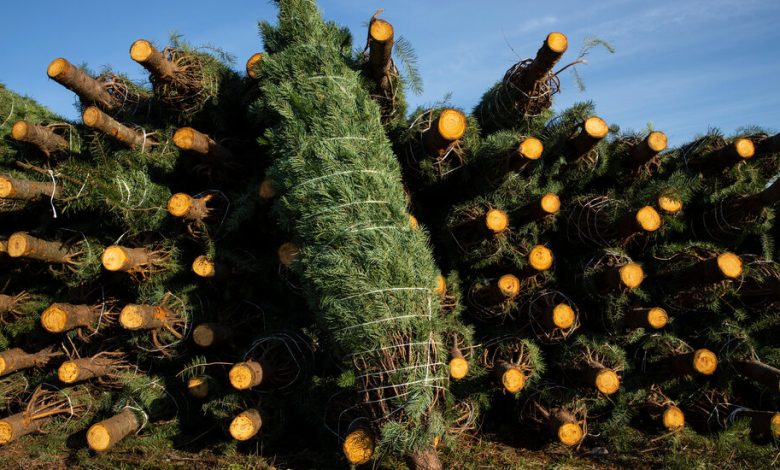How Christmas Tree Farms Can Help Wildlife

A few years after the Society for the Protection of New Hampshire Forests started a Christmas tree farm, Nigel Manley, who oversaw the operations, began noticing some interesting developments among the rows of fragrant balsam and Fraser firs lining the land.
In the spring, areas around the younger trees drew ground nesters like bobolinks — songbirds that migrate to and from South America — killdeer and woodcocks, who availed themselves of the open spaces to perform their courtship flights and rear their young. Deer hid their fawns in long grasses. Waxwings and robins nested in older trees, their young fledging many months before harvest. Mice and voles living on the land drew foxes and migratory raptors such as kestrels and harriers, who feasted on the cornucopia each time the grass was mowed.
In these climatically perilous times, when the cooling and oxygenating properties of trees have never been more valued, it seems counterintuitive to support chopping them down. Yet, the ecological benefits of real Christmas trees are why many environmentalists endorse them over the fake, petroleum-based versions that are shipped from half a world away.
Christmas tree farms can function much like young forests, said Andy Finton, a forest ecologist with the Nature Conservancy in Massachusetts. Two to three saplings are generally planted for every tree harvested, and, according to Jill Sidebottom, a spokeswoman for the National Christmas Tree Association, Christmas tree farms are often cultivated on otherwise unused farmland, allowing growers to keep their green spaces.
“They’re pulling carbon from the atmosphere,” Mr. Finton said of the trees. “They’re cleaning the air and, in many cases, cleaning the drinking water. They’re keeping the landscape undeveloped, preventing impervious surfaces, by giving economic incentives to landowners.”
With intense development pressures and accelerating loss of natural woodlands, he said, tree farms can provide habitats for wildlife, especially birds and mammals that prefer open spaces at forest edges.
A German study published last year found that conifer plantations could provide important refuges for four threatened species of farmland birds: the common linnet, tree pipit, woodlark and yellowhammer. Where ground cover is used, pollinating insects can benefit. Ten years ago, researchers documented 80 plant species at tree farms in North Carolina, including milkweed growing waist-high at the edges of fields, which drew 17 genera of bees and predatory insects that gobbled up tree pests.
Tom Norby, the president of the Pacific Northwest Christmas Tree Association, said that a small portion of the trees were harvested each year, leaving roughly 90 percent growing and available for animals. On his own farm, he has seen deer, rabbits, a pygmy owl, bears, coyotes and cougars, who follow elk that forage in his fields when mountain ranges are covered in snow.
Support for the farms is not universal. Nathan Donley, the environmental health director at the Center for Biological Diversity, said that a real tree was far preferable to a plastic one, and that Christmas tree farms were ecologically superior to golf courses or athletic fields.
But he said that the big tree farms, particularly those in the Pacific Northwest, were generally tightly packed, single-crop plantations. While food crops are generally sprayed more times a year, he said he was concerned that the longer growth cycle of Christmas trees could mean a heavier, cumulative load of pesticide, which could end up in nearby rivers or streams. “You’re really grasping at straws for species that find benefit,” Dr. Donley said. “In the interest of efficiency, sustainability takes a back seat.”
Yet Bert Cregg, a professor of horticulture and forestry at Michigan State University, said that while pesticide use varied by species and region, Christmas tree growers generally want to minimize use of the chemicals. . Pesticides are expensive, he said, and many growers live on-site and don’t want to be exposed. He also said the increased use of ground cover, such as clover, lowered soil temperatures and drew in nitrogen, reducing the need for fertilizers.
Between 2013 and 2018, Christmas tree growers in North Carolina reported a 21 percent reduction in pesticide use. Mr. Norby also said that insecticide use was decreasing.
By the time trees reach consumers, experts agree, there is minimal residual pesticide left. There are also organic growers who offer untreated trees.
On the issue of whether it is advisable or ethical to chop down trees, David Mizejewski, a naturalist with the National Wildlife Federation, said Christmas trees should be viewed as an agricultural commodity.
“I grew up thinking the same, like, ‘Oh, no, killing the tree is bad,’” Mr. Mizejewski said. But that “urban environmentalist” attitude, he said, amounted to a simplified view of the complexity of life, and death, on the planet. “Just like you eat broccoli, you kill the broccoli plant, right?” he said.
After Christmas, he said, many municipalities grind up Christmas trees for compost or use them as bulwarks against beach erosion. They can be sunk into ponds for fish habitats or broken up to provide shelter for backyard critters.
“None of that is to say that a Christmas tree farm is a replacement for untouched nature,” Mr. Mizejewski said. “I encourage people to think of things through an ecological lens, where everything has a life cycle. And what’s more important is that while it’s living, it’s actually contributing to that ecosystem.”



